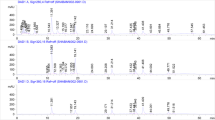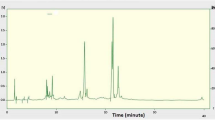Abstract
The aim of this study was to evaluate the therapeutic properties of Mimosa caesalpiniifolia in liver of rats exposed to cadmium under morphological, oxidative, inflammatory, and mutagenic parameters. A total of 40 Wistar rats (90 days, ~ 250 g) were distributed into eight groups (n = 5) as follows: (i) control; (ii) cadmium: cadmium chloride injection at 1.2 mg/kg; (iii) Mimosa extract: treatment with Mimosa extract at 250 mg/kg; (iv) Mimosa fraction: treatment with Mimosa acetate fraction at 62.5 mg/kg; (v) cadmium and Mimosa extract 62.5: submitted to cadmium chloride at 1.2 mg/kg injection and treatment with Mimosa extract at 62.5 mg/kg; (vi) cadmium and Mimosa extract 125: subjected to cadmium chloride at 1.2 mg/kg injection and treatment with Mimosa extract at 125 mg/kg; (vii) cadmium and Mimosa 250 extract: submitted to cadmium chloride 1.2 mg/kg injection and treatment with Mimosa extract at 250 mg/kg; (viii) cadmium treated with fraction of Mimosa acetate: submitted to cadmium chloride 1.2 mg/kg injection and treatment with acetate fraction of Mimosa extract at 62.5 mg/kg. In the animals intoxicated with cadmium and treated with fraction [62.5], increased expression of SOD-Mn reduced frequency of binucleated hepatocytes, karyolysis, and karyorrhexis, besides the antimutagenic and antioxidant action. The extract [62.5] was cytoprotective, antimutagenic, and reduced karyolysis. The extract [125] was cytoprotective, antioxidant, antifibrotic, anti-inflammatory, and reduced frequency of binucleated hepatocytes, while extract [250] was cytotoxic and mutagenic. In summary, the extract of Mimosa exerts some therapeutic properties in hepatic tissue after Cd intoxication, but only when it is administrated at intermediate doses. Probably, a high content of polyphenols in the EHM [250] and Fr-EtOAc groups exert pro-oxidant activities in the liver particularly when associated with Cd.





Similar content being viewed by others
References
Abdelaziz I, Elhabiby MI, Ashour AA (2013) Toxicity of cadmium and protective effect of bee honey, vitamins C and B complex. Human Exp Toxicol 32(4):362–370
Abdelhalim MA, Jarrar BM. (2011) Gold nanoparticles induced cloudy swelling to hydropic degeneration, cytoplasmic hyaline vacuolation, polymorphism, binucleation, karyopyknosis, karyolysis, karyorrhexis and necrosis in the liver. Lipids Health Dis 10:166
Ahmad K, Wajid K, Khan ZI, Ugulu I, Memoona H, Sana M, Nawaz K, Malik IS, Bashir H, Sher M (2019) Evaluation of potential toxic metals accumulation in wheat irrigated with wastewater. Bull Environ Contam Toxicol in press
Bernhoft RA (2013) Cadmium toxicity and treatment. Sci World J 394652
Boiago Gollucke AP, Claudio SR, Yamamura H, Morais DR, Bataglion GA, Eberlin MN, Aguiar O Jr, Ribeiro DA (2018) Grape skin extract mitigates tissue degeneration, genotoxicity, and oxidative status in multiple organs of rats exposed to cadmium. Eur J Cancer Prev 27(1):70–81
Choong G, Liu Y, Templeton DM (2014) Interplay of calcium and cadmium in mediating cadmium toxicity. Chem Biol Interact 211:54–65
Claudio SR, Gollucke AP, Yamamura H, Morais DR, Bataglion GA, Eberlin MN, Peres RC, Oshima CT, Ribeiro DA (2016) Purple carrot extract protects against cadmium intoxication in multiple organs of rats: genotoxicity, oxidative stress and tissue morphology analyses. J Trace Elem Biol Med 33:37–47
Cruz MP, Andrade CM, Silva KO, de Souza EP, Yatsuda R, Marques LM, David JP, David JM, Napimoga MH, Clemente-Napimoga JT (2016) Antinoceptive and anti-inflammatory activities of the ethanolic extract, fractions and flavones isolated from Mimosa tenuiflora (Willd.) Poir (Leguminosae). PLoS One 11(3):e0150839
Cupertino MC, Costa KL, Santos DC, Novaes RD, Condessa SS, Neves AC, Oliveira JA, Matta SL (2013) Long-lasting morphofunctional remodelling of liver parenchyma and stroma after a single exposure to low and moderate doses of cadmium in rats. Int J Exp Pathol 94(5):343–351
De Moura CFG, Ribeiro FAP, Lucke G, Gollucke APB, Oshima CTF, Ribeiro DA (2015) Apple juice attenuates genotoxicity and oxidative stress induced by cadmium exposure in multiple organs of rats. J Trace Elem Biol Med 32:7–12
Eghbaliferiz S, Iranshahi M (2016) Prooxidant activity of polyphenols, flavonoids, anthocyanins and carotenoids: updated review of mechanisms and catalyzing metals. Phytother Res 30(9):1379–1391
El-Mansy AA, Mazroa SA, Hamed WS, Yaseen AH, El-Mohandes EA (2016) Histological and immunohistochemical effects of Curcuma longa on activation of rat hepatic stellate cells after cadmium induced hepatotoxicity. Biotech Histochem 91(3):170–181
Fu B, Zhao J, Peng W, Wu H, Zhang Y (2017) Resveratrol rescues cadmium-induced mitochondrial injury by enhancing transcriptional regulation of PGC-1α and SOD2 via the Sirt3/FoxO3a pathway in TCMK-1 cells. Biochem Biophys Res Commun 486(1):198–204
Ivanova J, Gluhcheva Y, Tsanova D, Piskova A, Djaleva R, Mokresheva S, Kamenova D, Mitewa, M (2013) On the effect of chelating agents and antioxidants on cadmium-induced organ toxicity. An overview. Eur J Chem 4(1):74–84
Kaur J, Sidhu S, Chopra K, Khan MU (2016) Protective effect of Mimosa pudica L. in an L-arginine model of acute necrotising pancreatitis in rats. J Nat Med 70(3):423–434
Li X, Jiang X, Sun J, Zhu C, Li X, Tian L, Liu L, Bai W (2017) Cytoprotective effects of dietary flavonoids against cadmium-induced toxicity. Ann Nat Acad Sci 1398(1):5–19
Liu GD, Sheng Z, Wang YF, Han YL, Zhou Y, Zhu JQ (2016) Glutathione peroxidase 1 expression, malondialdehyde levels and histological alterations in the liver of Acrossocheilus fasciatus exposed to cadmium chloride. Gene 578(2):210–218
López E, Arce C, Oset-Gasque MJ, Cañadas S, González MP (2006) Cadmium induces reactive oxygen species generation and lipid peroxidation in cortical neurons in culture. Free Rad Biol Med 40(6):940–951
Pierigè F, Serafini S, Rossi L, Magnani M (2008) Cell-based drug delivery. Adv Drug Deliv Res 60(2):286–295
Pizzino G, Irrera N, Bitto A, Pallio G, Mannino F, Arcoraci V, Arcoraci A, Aliquo F, Minutoli L, Ponte C, D’andrea P, Squadrito F, Altavilla D (2017) Cadmium-induced oxidative stress impairs glycemic control in adolescents. Oxidat Med Cell Longev 6341671
Predes FS, Diamante MA, Dolder H (2010) Testis response to low doses of cadmium in Wistar rats. Int J Exp Pathol 91:125–131
Prista LN, Alves AC, MOrgato RMR (1995) Tecnologia Farmacêutica, Fundação Calouste Gulbenkian: Lisboa, v. 1, 5ª ed. p. 199-478
Rahimzadeh MR, Rahimzadeh MR, Kazemi S, Moghadamnia AA (2017) Cadmium toxicity and treatment: an update. Casp J Int Med 8(3):135
Silva MJ, Vilegas W, da Silva MA, de Moura CF, Ribeiro FA, da Silva VH, Ribeiro DA (2014a) Mimosa (Mimosa caesalpiniifolia) prevents oxidative DNA damage induced by cadmium exposure in Wistar rats. Toxicol Mech Met24(8): 567–74
Silva MJD, Carvalho AJS, Rocha CQ, Vilegas W, Silva MA, Gouvea CMCP (2014b) Ethanolic extract of Mimosa caesalpiniifolia leaves: chemical characterization and cytotoxic effect on human breast cancer MCF-7 cell line. South Afric J Botany 93:64–69
Silva MJD, Vilegas W, da Silva MA, Paiotti APR, Pastrelo MM, Ruiz PLM, de Moura CFG, Oshima CTF, Ribeiro DA (2018) The anti-inflammatory potential of Mimosa caesalpiniifolia following experimental colitis: role of COX-2 and TNF-alpha expression. Drug Res (Stuttg) 68(4):196–204
Wang MJ, Chen F, Lau JTY, Hu YP (2017) Hepatocyte polyploidization and its association with pathophysiological processes. Cell Death Dis 8(5):e2805
WHO (2010) Exposure to cadmium: a major public health concern. Geneva: World Health Organization. Available at: http://www.who.int/ipcs/assessment/public_health/cadmium/en/ (assessed: 19/03/2018)
Wu L, Zhang Q, Mo W, Feng J, Li S, Li J et al (2017) Quercetin prevents hepatic fibrosis by inhibiting hepatic stellate cell activation and reducing autophagy via the TGF-β1/Smads and PI3K/Akt pathways. Sci Rep 7:9289
Acknowledgments
ECL is a recipient from CAPES (Coordenação de Aperfeiçoamento de Pessoal de Nivel Superior), master program scholarship. MJDS and ABS are recipients from FAPESP (Fundação de Amparo à Pesquisa do Estado de São Paulo), PhD and post-doctoral program scholarships. WV, LPP, and DAR are recipients from CNPq (Conselho Nacional de Desenvolvimento Cientifico e Tecnologico), productivity fellowships.
Author information
Authors and Affiliations
Corresponding author
Ethics declarations
The study was approved by the Animal Ethics Committee of the Federal University of São Paulo, UNIFESP, São Paulo, Brazil (CEUA, protocol number 6615170117).
Conflict of interest
The authors declare that they have no conflict of interest.
Additional information
Responsible editor: Philippe Garrigues
Publisher’s note
Springer Nature remains neutral with regard to jurisdictional claims in published maps and institutional affiliations.
Rights and permissions
About this article
Cite this article
de Lima, E.C., de Moura, C.F.G., Silva, M.J.D. et al. Therapeutical properties of Mimosa caesalpiniifolia in rat liver intoxicated with cadmium. Environ Sci Pollut Res 27, 10981–10989 (2020). https://doi.org/10.1007/s11356-019-07455-2
Received:
Accepted:
Published:
Issue Date:
DOI: https://doi.org/10.1007/s11356-019-07455-2




